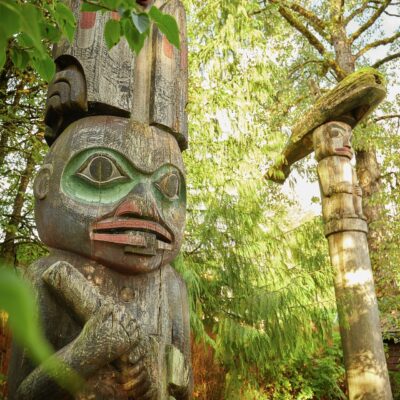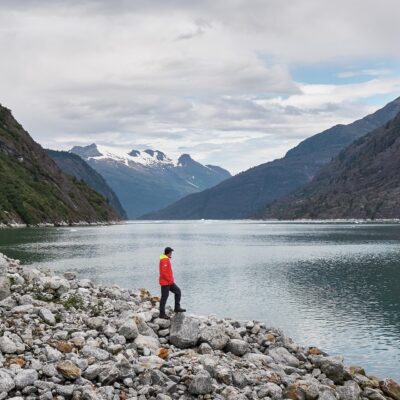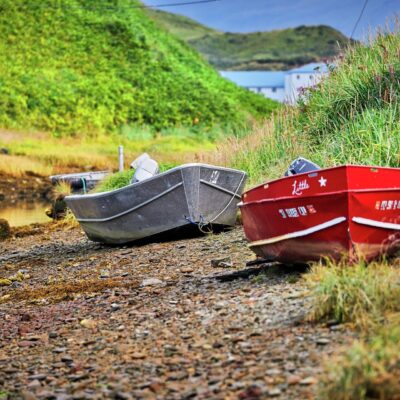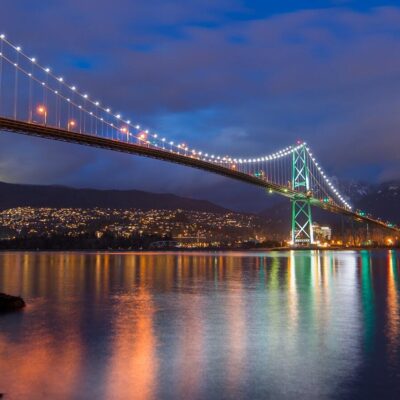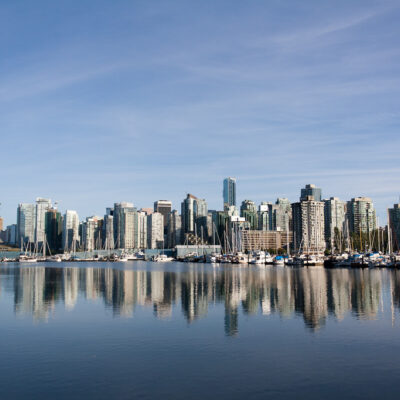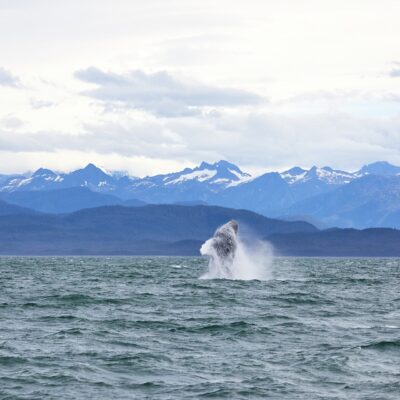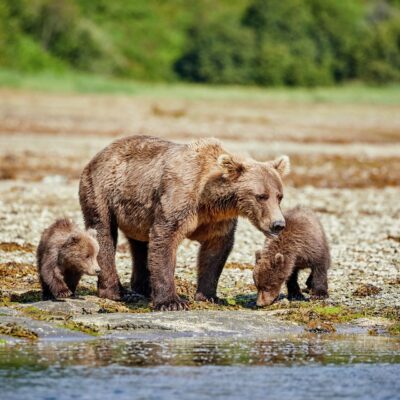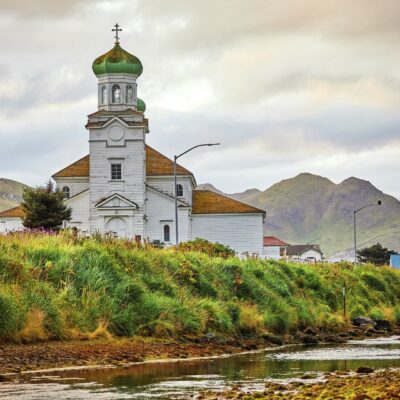Departing in July of 2022, this expedition is one to remember. You will discover the wild nature and rich culture of Alaska, sailing through the Inside Passage and exploring the Aleutian Islands and historic frontier towns.
Overview
Itinerary
Pack your adventure gear and off you go. On this expedition style cruise with a company focused on sustainability, you will experience the culture, nature and landscapes of Alaska.
Day 1 - July 22, 2022
Vancouver, British Columbia
Start your tour with an overnight in Vancouver. If you are from Vancouver, experience the city as a tourist. If you are joining us from further afield, take the time to enjoy local neighbourhoods such as Gastown, Yale town, Stanley park or the Granville Street strip.
Day 2 - July 23, 2022
Arrive into Nome, Alaska
Today join your fellow explorers and take a flight from Vancouver to Nome, Alaska. Here is where the journey really starts! Nome is situated on the Seward Peninsula, Nome’s name went down in Alaska history the day the ‘Three Lucky Swedes’ discovered gold in Anvil Creek in 1898. Prospectors soon flocked from the Yukon and from San Francisco in steamers. Even the famous sheriff Wyatt Earp followed the call of gold and opened a saloon here.
You can see evidence of the gold rush era everywhere, including abandoned dredges, turn-of-the-century steam engines, and old railroad tracks. Cries of ‘Gold! Gold!’ can still be heard today by those foraging on the banks of the Snake River and elsewhere in the area.
Day 3 - July 24, 2022
Sailing Day AND crossing the International Date line!
Sailing south into the open ocean, you’ll feel the thrill of setting out on a great adventure as we navigate through the Bering Sea.
On your first day at sea, keep an eye on the waters here for humpback whales. As the ship sails through the Bering Strait, look to the skies to spot a range of sea birds. You’ll have Russia to the east and the USA to the west. This is also the international date line, so you’ll have ‘tomorrow’ on your left and ‘today’ to the right.
As our journey gets underway you may want to join our Expedition Team at the onboard Science Center and attend a fascinating lecture, spend time getting to know your fellow travellers.
Day 4 - July 25, 2022
St Matthews Island in the Aleutian Islands
St. Matthew Island lies halfway across the Bering Sea, between Russia and the USA. Coming ashore on its black sand beaches, we’ll be the only humans on the isle.
Separated from the nearest village by more than 200 miles, this is probably the single most isolated place in Alaska. And that’s saying something given how sparsely populated the state is to begin with.
Many pioneers attempted to settle this island over the centuries, but none ever stayed long due to the frequent fog, storms, and tough winters. Even introduced populations of hardy reindeer which grew into the thousands soon dwindled and disappeared.
Traces of human life still remain on the island though, with abandoned dwellings half buried in the wildflower-speckled tundra. Lichen-covered bones and fishing debris are also strewn across some of the beaches, washed up in sea storms.
The island is part of the Alaska Maritime National Wildlife Refuge and home only to nesting seabirds like Murres, Puffins, and Cormorants, as well as foxes who pilfer eggs from the nests.
Listen out for the native singing voles, who were named after their distinctive warning cry, and get your camera ready in case the rare McKay's Bunting appears, which breeds almost exclusively on St. Matthew Island.
Day 5 - July 26, 2022
St Paul, Alaska
The windswept island of St. Paul is the largest of the Pribilof Islands. The only inhabitants huddle in the village of St. Paul with a population of 480 residents. Close to 90% are indigenous Aleuts, representing the largest Aleut community in the US.
As part of the strong Aleut heritage here, there are historical sites that showcase the remains of barabaras, traditional semi-subterranean Aleut houses made from soil. The unique design allowed for the abode to be less exposed to the strongs winds of the Bering Sea and for the ground to act as natural insulation to keep in the heat.
Designated as an Important Bird Area, St. Paul Island is an ideal resting point for migrating birds, attracting some 300 species. See if you can spot a horned or tufted puffin or a Pribilof sandpiper during your visit. The big draw for birders and ornithologists here though is the endemic red-legged kittiwakes who nest on the island.
The isle is also home to the northern fur seal, with about half the world’s population living around the Pribilof islands. You can watch these active creatures waddling along the shore and splashing in the water, and in the early summer months you may even see seal pups playing on the beach.
Day 6 - July 27, 2022
Sailing Day
Part of being on an expedition is knowing how to enjoy the moment; taking time out to reconnect with nature and the world around you.
So park yourself in the panoramic Explorer Lounge or soak in a hot tub out on deck, sit back and simply take in the serene scenery as untouched isles and green mountains roll quietly by.
You’ll also be able to join the Expedition Team in the Science Centre so that they can continue to enthrall you with details about the local geography, climate and birdlife.
There’s also a chance to see seabirds like the endemic and rare Red-legged Kittiwake, Puffins, Auklets, and Murrelets, especially when we are closer to the coast.
Day 7 - July 28, 2022
Dutch Harbor, Alaska
Dutch Harbor lies on the southern shores of Amaknak Island, part of the Fox Islands group of the Aleutians. As we approach it, you may have views of Mount Makushin, a steaming volcano almost 6,000-feet high. The city here is officially called Unalaska, but most residents in the region just refer to it as ‘Dutch’ after the harbor.
The city thrives on commercial fishing and in terms of the sheer volume of seafood caught in America, Dutch Harbor has ranked right at the top for 20 years straight. You might even recognise it from the popular TV show ‘The Deadliest Catch’ which follows the highs and lows of local fishing crews who battle the elements to harvest Alaskan king crabs.
Stop in at the Museum of the Aleutians to explore the rich culture and history of the indigenous Unungan people who have lived in harmony with nature around Dutch Harbor for some 10,000 years.
Russia also colonized Unalaska in the 1700s, turning it into an outpost for fur traders. The Russian Orthodox Cathedral of the Holy Ascension of Christ dates to 1896. Together with its unique domes, it is the oldest cruciform-style Orthodox church in North America.
To the north of Amaknak Island is the Aleutian World War II National Historic Area, littered with barracks, concrete bunkers, and ruins of gun batteries. 1942 saw the Battle of Dutch Harbor when it was hit by Japanese bombers. This makes it one of only a few places in the US directly attacked during WWII, alongside Pearl Harbor in Hawaii.
You’ll want to keep your eyes peeled for the more-than-600 bald eagles around town, along with some 40-50 million seabirds such as puffins, cormorants, and kittiwakes.
The shores have foxes, squirrels, lemmings, and even a herd of wild horses at Summer Bay. Marine life tends to be a mixture of humpbacks, orcas, sperm whales, gray whales, sea otters, sea lions, and harbor porpoises.
Day 8 - July 29, 2022
Unga Village - An Alaskan Ghost Town
Unga Village is a picturesque but abandoned town on the southern end of uninhabited Unga Island in the remote Aleutian Islands. Settled by Aleuts in 1833, subsistence fishing proved insufficient to support the community, which had all but moved by 1969. Today, a collection of wooden buildings is all that remains, surrounded by a carpet of pink louseworts and fireweed.
Day 9 - July 30, 2022
Chignik, Alaska
The small village of Chignik Bay is a prime example of the typical fishing settlements in Alaska. Red salmon fishing has been the core of the community’s economy for over a century. Stop in at the fish factory, meet the welcoming locals, or explore the salmon streams in the scenic surroundings. Scan the shores to spot the 20-or-so waterfowl species, or the skies for bald eagles.
Day 10 - July 31, 2022
Sailing around the Aleutian harbours and bays
Welcome to Katmai National Park. This is four million acres, over a dozen active volcanos, and the location of the dramatic Valley of Ten Thousand Smokes – itself the site of one of the most devastating volcanic eruptions ever recorded.
We’ll spend the day cruising and looking for bears from deck or from our small explorer boats at one of three possible sites in the park, each of which are known for their communities of brown bears. Katmai National Park is almost synonymous with excellent bear watching. It has the largest population of protected grizzly bears alone, numbering more than 2,000.
Of the three areas we’ll sail to, it could be Geographic Harbor at the top of Amalik Bay, a lagoon fringed by moss-covered rocks and rolling hills and famous for its brown bear population. Or perhaps you’ll get to visit secluded Kinak Bay to uncover its hidden yet charming beaches. Or maybe it’ll be Kukak Bay where a wide estuary provides a steady stream of salmon for the hungry bear.
Which point of interest will depend on weather conditions in the area at the time. This will be at the Captain’s discretion, in collaboration with the Expedition Team. If time allows, we may even try to see more than one site. Rest assured that whichever place you visit today, it’ll really be the best choice that takes into account a whole range of factors.
Accompanied by an experienced bear guard, you’ll hopefully be able to observe brown bears from a safe distance, getting close but never too close. In any case, the bears are likely be too busy foraging for berries along the shore, diving for clams, and fishing in the mountain rivers to even pay us much attention.
Aside from bear watching, you’ll have great chances of seeing the amazing sea otter today too. The Shelikof Strait is also notable for humpback whales. Then, there’s the splendid scenery of snow-capped mountains and verdant forest to admire, and a good number of seabirds to spot.
Day 11 - August 1, 2022
Kodiak, Alaska
The bustling fishing port of Kodiak, largest in Alaska, sits on the eastern shores of Kodiak Island. The surrounding spruce forest and grassland here have inspired its nickname as the ‘Emerald Isle’. At 3,670 square miles and over 100 miles in length, this is the largest island in Alaska, and the second largest in the US after Hawaii.
Alutiiq natives lived here for over 7,000 years before the Russian crown came and claimed the island as its earliest capital in Alaska. There are thousands of artefacts and photos to admire at the Alutiiq Museum. You can also visit the 1808 Baranov Museum, the oldest standing building in the state and a former Russian fur pelt storehouse.
World War II saw Kodiak transformed into an important launch pad for US naval operations in the North Pacific. You can visit Fort Abercrombie State Historical Park to see the 1939 fort and a series of coastal bunkers. The fort itself now serves as the base for the largest Coast Guard team in the country.
The best-known park here though is the Kodiak National Wildlife Refuge, covering two-thirds of the island. A range of habitats from mountains to meadows are home to the islands most famous residents: about 3,500 Kodiak brown bears.
Day 12 - August 2, 2022
Sailing Day
A day at sea gives you all the time you need to rest, relax, take stock of what you’ve experienced so far and to build excitement for your adventure ahead. You’ll definitely want to enjoy onboard facilities like the infinity pool, hot tubs, sauna, indoor gym, outdoor running track and spa.
Informative lectures from the Expedition Team continue in the Science Centre. Each topic, ranging from wildlife, tectonic activity, glaciology, or local history and culture, is designed to help you appreciate the areas you are sailing through and inform your upcoming landings.
You can also spend time getting to know the crew, Expedition Team, and fellow explorers. Aside from a passion for adventure, you may find you have similar interests and experiences. Why not share some drinks with them at the bar and strike up a camaraderie with your new shipmates?
Sailing through the Gulf of Alaska, there is a chance to see North Pacific albatrosses. There are three species to look for; laysan and black-footed albatrosses are common in the Gulf of Alaska, while the short-tailed albatross is a much rarer sight
Day 13 - August 3, 2022
Icy Bay, Alaska
Discover Icy Bay near Prince William Sound – a place that really lives up to its name. Three prominent glaciers of Guyot, Yahtse, and Tyndall feed vast chunks of floating ice into the waters of the bay.
The area here was once a giant tidewater glacier that ran directly into the Gulf of Alaska. The bay has only become accessible to ships in the past 100 years or so.
This was also the site of a mega-tsunami in 2015 when 180 million tonnes of mountain rock and forest collapsed into the fjord. The resulting wave is thought to have been one of the highest in the past century. Thankfully, the tsunami dissipated without doing any damage.
Our aim will be to visit the 55-km-long and 13-km-wide Guyot Glacier, depending on the amount of ice along the way and the local weather conditions. You’ll hopefully be able to go ashore as near to the glacier as is safe or explore the waters on kayaks as part of an optional excursion.
As ever, we’ll be on the lookout for all the awesome wildlife that abounds in the Gulf of Alaska, including humpback whales, orcas, Stellar sea lions, sea otters, harbor seals and many others.
This tough and rugged area is only matched by its natural beauty and there will be ample photographic opportunities throughout the day. The harbor seals, in particular, love to laze on floating ice.
Day 14 - August 4, 2022
Sitka, Alaska
Situated on Baranof Island on the outer coast of the Inside Passage, Sitka can only be reached by sea or by air. It’s also surrounded by Tongass National Forest, the largest temperate rainforest in the world. Sailing here, you’ll be able to enjoy views of the Sisters Mountains and of Mount Edgecumbe, a dormant volcano reminiscent of Japan’s Mount Fuji.
Originally inhabited by the Tlingit people over 10,000 years ago, it was conquered by Russia in 1804 and renamed ‘New Archangel’. By 1808, the city was the largest in the region and was designated the capital of Alaska. Today, you’ll find Sitka to be a place of blended culture. Tlingit traditions remain strong, existing side by side with Russian and American influences.
With Russia reeling from the Crimean War, it sold Alaska to the US to keep it out of the hands of the British. The location of the transfer ceremony in 1867 was none other than New Archangel which was promptly renamed as ‘Sitka’. At the meagre price of $7.2 million for the entire region, it was a steal at just two cents per acre!
There are historic sites aplenty in Sitka, such as the Russian Bishop’s House which is the oldest intact building here, dating back to 1842. Or you can visit the Russian Orthodox St. Michael’s Cathedral which still features its original chandelier, religious art, and a range of other artefacts.
A highlight for most visitors to Sitka is the 107-acre Sitka National Historic Park. There is a fascinating museum here with a range of exhibits. You can then follow a trail that leads you by the ocean through a peaceful forest. Along the way, you’ll also discover beautiful examples of ornate Haida and Tlingit totem poles.
Day 15 - August 5, 2022
Wrangell, Alaska
You’ll really feel like you’re stepping back in time at Wrangell, one of Alaska’s oldest and most historic island towns. Ancient petroglyph carvings dot the beach here, and it’s only a 15-minute walk to where you can start noticing them. There are about 50 in total, so see how many you can find.
Afterwards, why not pay a visit to the Wrangell Museum, which is packed full of interesting artefacts and information about the history of the town. While Wrangell is now part of America, it was previously governed by Great Britain, Russia, and the Tlingit people as far back as 8,000 years ago.
Then there’s the moss-covered totem poles at the Chief Shakes Tribal House which tell the story of the local Tlingit people. You’ll find the Tribal House, which is beautifully constructed from cedar wood, a short walk from the town centre over the wooden bridge to Shakes Island.
Being surrounded by such alluring scenery at the mouth of Stikine River and at the foot of Mount Dewey, it’ll be easy to get back to nature on one of the local trails to the edge of the rainforest.
Day 16 - August 6, 2022
Misty Fjords National Park
The first area you’ll explore on your expedition is none other than the spectacular Misty Fjords National Monument. Part of the two million acres of Tongass National Forest, this is a pristine coastal wilderness of evergreen trees, deep fjords, and majestic snow-capped peaks.
The region receives more than 150 inches (380 cm) of rain a year, feeding rivers and lakes that run into waterfalls that tumble from the dark granite cliffs. The mountains rise almost vertically from the fjords to heights of 3,000 feet (1,000 m) or more, covered in cedar, spruce, hemlock, and moss.
Influential Scottish-American mountaineer John Muir, also known as ‘Father of the National Parks’, famously declared the Misty Fjords as one of the most beautiful places he’d ever seen. We hope you’ll be similarly inspired as we explore the area. If the weather allows, you’ll tour the area aboard our small explorer boats or while kayaking on an optional excursion.
Keep your eyes peeled to possibly spot mountain goat, brown bear, black bear, and moose, whether along the shores, the ridges, or slopes. In the waters, all five species of Pacific salmon swim, along with river otters, sea otters, sea lions, harbour seals, orcas and Dall porpoises. Have your binoculars at the ready for the likes of hummingbirds, trumpeter swans, herons, and that great icon of America: the bald eagle.
Day 17 - August 7, 2022
Sailing Day - The Inside Passage
The great North American Pacific Fjordland is a protected stretch of water almost 1,500km long and known for its relatively calm waters and lack of ocean swells.
Our expedition ship is small enough to pass through and get close to the many interesting and scenic channels of the Inside Passage. Don’t forget your binoculars!
It’s the ideal time to wind down from all the excitement of Alaska. Pamper yourself in the Wellness Spa with a few soothing treatments. And reminisce on the trip’s special memories with new-found friends in the bar.
The Expedition Team will be in a similar mood as they recap the expedition in the Science Center. Here, you can proudly compare your best photographs and swap stories of the different excursions.
Day 18 - August 8, 2022
Vancouver, Canada
Your expedition concludes back in Vancouver. If you’ve arranged to spend more time here at the end of your journey, there’s always something cultural going on in this picturesque metropolis between water and mountains.
Take in a few of its many art galleries or learn about First Nations cultures at the museums. Go on a café crawl on trendy Granville Island, or visit the multicultural food stalls at the night market in Richmond. You can also make the most of the summer weather over at sandy Kitsilano Beach.
Details
Included
Not Included
Booking Contact
18 Day Tour
Pricing is per person based on twin share. This rate includes a 20% Canada residency discount and $150USD per person onboard credit.

